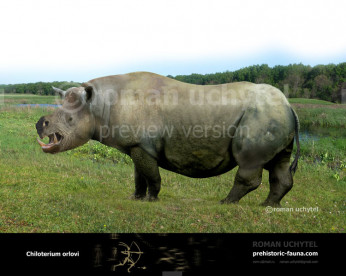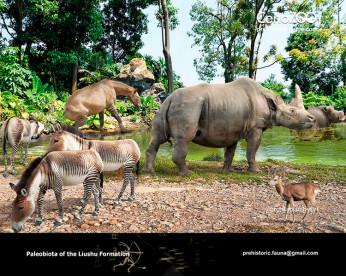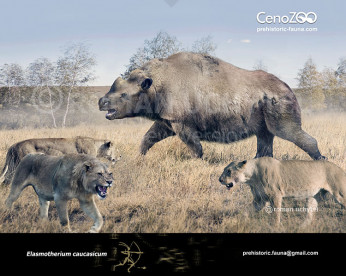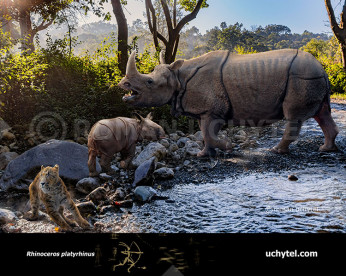Iranotherium
1000000009210000000092
Iranotherium (†Iranotherium morgani (Mecquenem, 1908))
Order: Perissodactyla
Family: Rhinocerotidae
Size: 3.5-4 m in length, 160-180 cm in height, ~3000 kg of weight
Time period: the Late Miocene (Arabia and Asia)
Iranotherium was a genus of large elasmotheriine rhinoceros, comparable in size to a modern white rhino. It is known from the Late Miocene (Tortonian) of Maragha, Iran and the middle part of the Liushu formation of northwestern China. This species is most well known for showing unique sexual dimorphism among rhinos.
The skull of Iranotherium was a long and concave, with a length of 775 mm. The skulls also show distinct sexual dimorphism: The base from which the horn grows is large and strong in the male, while it is small and weak in the female, and there is strong and rough rugosities present on the back half part of the zygomatic arch of the male. Additional sexually dimorphic features include the zygomatic arch of the male being thicker than that of the female. These features, especially the nasal horn, could be used for defense or competition for mates.
Iranotherium was a grazer since its denition is that of a hypsodont. In life it would've had wide and flat lips like those of the extant White Rhino.
The absolute body size of an herbivore is very important in determining the fiber/protein ratio, therefore, the giant body size of I. morgani implies that this species grazed high-fiber grasses and obviously inhabited an open grassland.
In 2005, two skulls of Iranotherium were described by Tao Deng. One skull was from an adult female Iranotherium and the other from a young adult male. These skulls, when compared showed significant, sexually dimorphic differences. The male had rugosities present on each zygomatic arch, whereas the females lacked them entirely. This unique feature is virtually unknown among other rhinocerotids. Male Iranotherium are hypothesized to bear it for supporting larger masseteric and temporalis musculature.
Iranotherium was a precursor to the related Sinotherium and may have been ultimately outcompeted by its descendant.
It lived in a forested environment in Iran whereas it occupied a more open habitat in China.
It was contemporary with hipparions, mustelids, hyaenids-Ictitherium, Dinocrocuta gigantea, Amphimachairodus giganteus and Samotherium.
Оплата
У Вас є кілька зручних способів купівлі зображення: кредитна чи дебетова картка Visa, Mastercard, Maestro; PayPal або банківський переказ
Iranotherium (†Iranotherium morgani (Mecquenem, 1908))
Order: Perissodactyla
Family: Rhinocerotidae
Size: 3.5-4 m in length, 160-180 cm in height, ~3000 kg of weight
Time period: the Late Miocene (Arabia and Asia)
Iranotherium was a genus of large elasmotheriine rhinoceros, comparable in size to a modern white rhino. It is known from the Late Miocene (Tortonian) of Maragha, Iran and the middle part of the Liushu formation of northwestern China. This species is most well known for showing unique sexual dimorphism among rhinos.
The skull of Iranotherium was a long and concave, with a length of 775 mm. The skulls also show distinct sexual dimorphism: The base from which the horn grows is large and strong in the male, while it is small and weak in the female, and there is strong and rough rugosities present on the back half part of the zygomatic arch of the male. Additional sexually dimorphic features include the zygomatic arch of the male being thicker than that of the female. These features, especially the nasal horn, could be used for defense or competition for mates.
Iranotherium was a grazer since its denition is that of a hypsodont. In life it would've had wide and flat lips like those of the extant White Rhino.
The absolute body size of an herbivore is very important in determining the fiber/protein ratio, therefore, the giant body size of I. morgani implies that this species grazed high-fiber grasses and obviously inhabited an open grassland.
In 2005, two skulls of Iranotherium were described by Tao Deng. One skull was from an adult female Iranotherium and the other from a young adult male. These skulls, when compared showed significant, sexually dimorphic differences. The male had rugosities present on each zygomatic arch, whereas the females lacked them entirely. This unique feature is virtually unknown among other rhinocerotids. Male Iranotherium are hypothesized to bear it for supporting larger masseteric and temporalis musculature.
Iranotherium was a precursor to the related Sinotherium and may have been ultimately outcompeted by its descendant.
It lived in a forested environment in Iran whereas it occupied a more open habitat in China.
It was contemporary with hipparions, mustelids, hyaenids-Ictitherium, Dinocrocuta gigantea, Amphimachairodus giganteus and Samotherium.

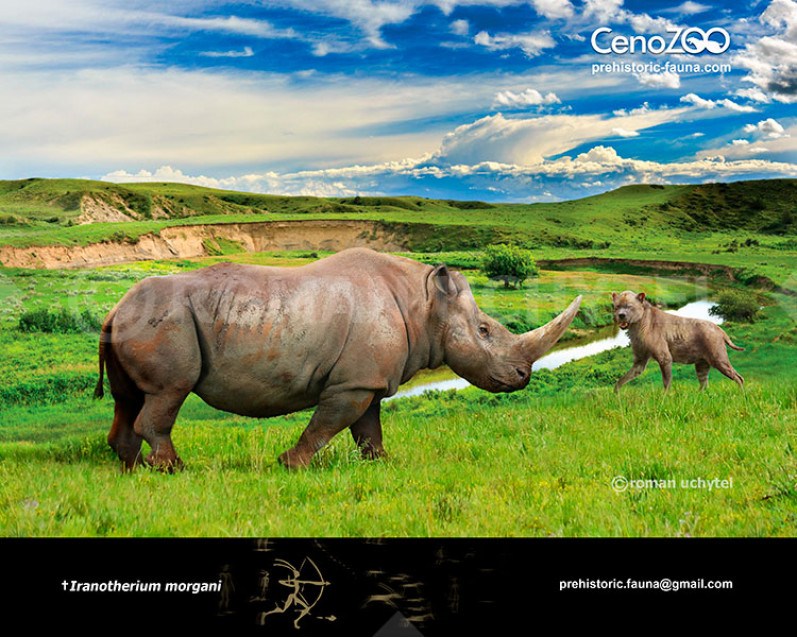
-797x638.jpg)

-70x56.jpg)

